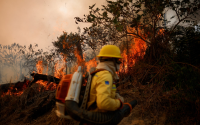3 February 1007David Adam
The world's scientists yesterday gave their starkest warning yet that a failure to cut greenhouse gas emissions will bring devastating climate change within a few decades.
Average temperatures could increase by as much as 6.4C by the end of the century if emissions continue to rise, with a rise of 4C most likely, according to the final report of an expert panel set up by the UN to study the problem. The forecast is higher than previous estimates, because scientists have discovered that Earth's land and oceans are becoming less able to absorb carbon dioxide.
An average global temperature rise of 4C would wipe out hundreds of species, bring extreme food and water shortages in vulnerable countries and cause catastrophic floods that would displace hundreds of millions of people. Warming would be much more severe towards the poles, which could accelerate melting of the Greenland and west Antarctic ice sheets.
The report, from the Intergovernmental Panel on Climate Change (IPCC), is written by hundreds of scientists across the world and has been approved by every government. It leaves little room for doubt that human activity is to blame. Achim Steiner, executive director of the UN Environment Programme, said: "February 2 2007 may be remembered as the day the question mark was removed from whether people are to blame for climate change."
The report itself said human activity was "very likely" to be responsible for most of the observed warming in recent decades, which means the scientists are 90% sure.
The new warning comes as world governments face increasing pressure to agree a new global deal to reduce emissions.
Susan Solomon, the co-chair of the IPCC working group that prepared the report, said: "If we keep emitting greenhouse gases at current rates we will see bigger changes this century than we did in the previous century. The amount of warming will depend on choices that human beings make."
The previous IPCC report, in 2001, said that failure to act could bring global warming of up to 5.8C by 2100.
Dr Solomon said yesterday's predictions painted a gloomier picture because scientists have discovered feedbacks in the global carbon cycle that are adding to the amount of carbon dioxide in the atmosphere. Early estimates say this would be enough to raise temperatures by at least another 1C by 2100.
A 4C rise or higher this century would see the world warm almost as much in 100 years as it did during the 15,000 years since the end of the last ice age.
The IPCC panel stressed that such an outcome was not inevitable. A significant switch to "clean and resource efficient technologies" would cut expected temperature rises by half. But even their most optimistic scenario would see a likely increase in temperature of 2.4C over pre-industrial levels by 2100. The EU has defined any rise over 2C as "dangerous".
David Miliband, the environment secretary, said the report was "another nail in the coffin of the climate change deniers and represents the most authoritative picture to date, showing that the debate over the science of climate change is well and truly over". He added: "What's now urgently needed is the international political commitment to take action. This has been absent so far."
What +4C will mean
Loss of food production
Droughts. African crops slump 15% to 35%. Global production falls 10%
Increased flooding
Sea levels rise by up to 59cm. Bangladesh and Vietnam worst hit, along with coastal cities such as London, New York, Tokyo, Hong Kong, Calcutta and Karachi. 1.8m people at risk from coastal flooding in Britain alone
Melting ice
Half the Arctic tundra at risk. Europe loses 80% of alpine glaciers. West Antarctic ice sheet and the Greenland ice sheet start to melt
More disease
Mosquitoes thrive, exposing 80 m more people to malaria in Africa; 2.5bn more exposed to dengue fever
Loss of land species
20-50% of land species threatened with extinction
Water shortages
Fresh water availability halved in southern Africa and Mediterranean
Hurricanes more powerful Wind strengths increasing 15-25%. Great damage to infrastructure
http://environment.guardian.co.uk/print/0,,329705036-121568,00.html






